#gustavo heide
Text
youtube
#ATP Tour#tennis#Matteo Berrettini#Alejandro Tabilo#Sebastian Baez#Thiago Agustin Tirante#Yannick Hanfmann#Gustavo Heide#Lukas Neumayer#Nicolas Moreno de Alboran
2 notes
·
View notes
Text
RG MS Q3: Meet Your Qualifiers (Day 1)
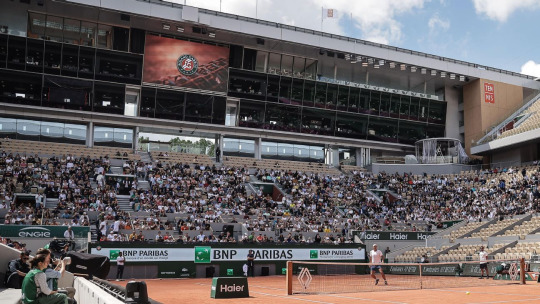
Illustration of Roland Garros qualifying rounds (📸 Archysport)
For a more compact version in the form of a Twitter thread, click here.
As per tradition in the French Open, differing from other Grand Slams, the third qualifying round matches are divided into two days, with one of the reasons likely being weather, as it turned out to rain upon the conclusion of the matches. Interestingly, due to the previous rain delays that happened yesterday, the 8 sections that finished first (3, 9-15) played today to find out the first 8 qualifiers to the Men's Singles sector in Roland Garros.
Recognizing that these qualifiers could often shock you (and your favorite players) in a way you will never imagine, meet your qualifiers (first part, also with the oversimplified match report):
Section 13: Shintaro Mochizuki def. Facundo Bagnis [13] 6-4, 2-0 ret.
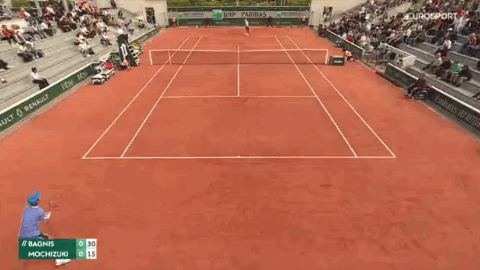
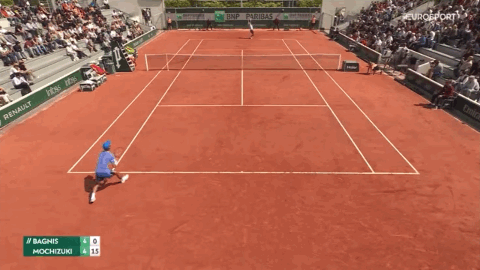
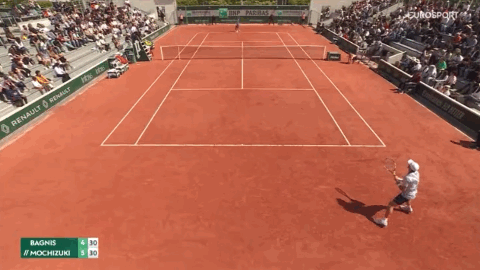
Shintaro Mochizuki's points to *0-0 30-30, 1st set (top left), to *4-4 0-30, 1st set (top right), and to set up his set point at *5-4 40-30, 1st set (bottom) (📸 Eurosport GB)
F. Bagnis came to the Roland Garros qualifying rounds thanks to shining through the Golden Swing, becoming the runner-up of Cordoba (250) to Luciano Darderi 1-6, 4-6, preceded by winning the Buenos Aires 2 (Argentino) Challenger against Mariano Navone in a comeback fashion 7-5, 1-6, 7-5 right before L. Darderi and M. Navone broke out. Trying to follow their journey in terms of resurgence, F. Bagnis continued with a runner-up showing in Santiago Challenger (l. Juan Pablo Varillas) and the quarterfinals in Aix-en-Provence Challenger albeit being unable to catch a break as he was forced to retire down 0-6 to eventual champion Alejandro Tabilo, coming to the Roland Garros third qualifying round without dropping a set as he defeated M. Tomas Barrios Vera and Juan Manuel Cerundolo both in straight sets (6-3, 6-2 and 6-4, 6-2, respectively). On the other hand, other than the competitive showing in the second round of Cagliari Challenger (l. Mariano Navone), S. Mochizuki might have shocked the most on paper as he stunned clay frequents Nick Hardt 4-6, 6-4, 6-2 and 18th seed Stefano Napolitano 6-3, 6-2 in a confident showing during the first two qualifying rounds, showing that his competitiveness paid off thanks to trusting his strokes and pacing. This match might not be any different, judging by how offensive both players could be, but being passive would not help as well as their past matches showed.
S. Mochizuki started the first set with an early break (1-0) thanks to his preceding forehand to 0-0* 30-30 in the first set, already outhitting F. Bagnis' forehand before consolidating his lead to 2-0. Despite being broken back to 2-2, he bounced back by breaking again to 5-4 thanks to his preceding backhand. He became more aggressive as he went after F. Bagnis' forehand to generate his break point, eventually breaking to 5-4. The same aggression that likely helped him to win the Barletta Challenger last year bore fruit as he took the first set 6-4, setting up his set point with a working volley beforehand. However, S. Mochizuki picked up decent form by breaking early to 1-0 thanks to his preceding backhand 2 points into the first game while F. Bagnis erred his forehands, followed by consolidation to 2-0, and the Argentinean 13th seed took a medical timeout for his left leg. Taking a precaution, he retired right before he served at the beginning of the third game, sending S. Mochizuki to the main draw, his third since he qualified for the Wimbledon Championships 2023 and became a lucky loser in the Australian Open 2024.
Section 15: Hamad Medjedovic [15] def. Geoffrey Blancaneaux 6-2, 6-2
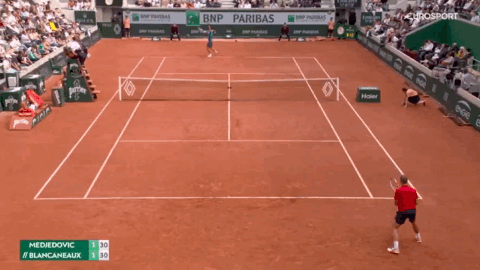
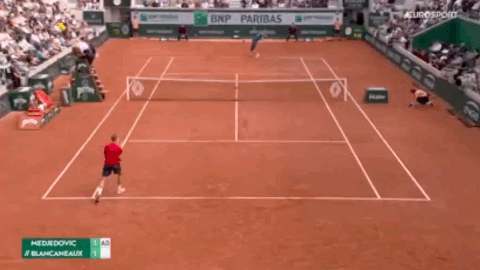
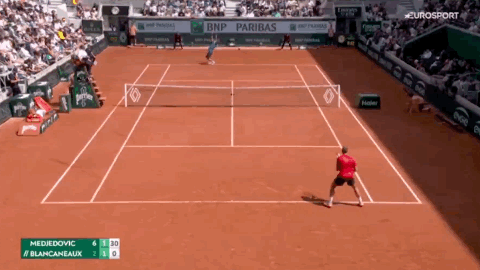
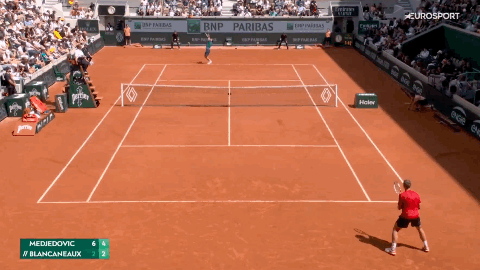
Hamad Medjedovic's points to 1-1* 15-40, 1st set (top left), to break 2-1, 1st set (top right), to 1-1* 0-40, 2nd set (top right), and to 4-2* 0-15 (bottom right) (📸 Eurosport GB)
After being back from illness, H. Medjedovic re-started his season with a bang, most notably taking a set off Daniil Medvedev despite the loss at 6-7(5), 6-2, 5-7 as a qualifier after defeating Alejandro Davidovich Fokina, all in the first two rounds of Rome Masters 1000. Here, he stunned Lucas Pouille 6-3, 7-5 in a high-quality battle during the first qualifying round, compared to G. Blancaneaux, who also qualified last year, had a poor clay season with the early exits even after winning the New Delhi Challenger on the hard courts, but he managed to score a Top 150 win in Duje Ajdukovic, 7-5, 6-4, in the second qualifying round. This match would test their offensives, where one who appeared more aggressive could prevail.
Even though H. Medjedovic had to survive a nervy start as he faced a break point earlier in the first game due to his forehand error, but he still managed to hold his serves to 1-0 in the first set. G. Blancaneaux might have started the third game with a forehand error, but the 2023 NextGen Finals champion scored his earliest break point of the game through a drop shot before converting it via a forehand winner (3-1). The former turned out to double the break thanks to his fourth-shot forehand winner, taking the first set 6-2 through an unreturned serve as he survived the tendency to rush his third-shot forehands midway. He continued the dominance in the second set as he fired a backhand down-the-line winner to create his break point in the third game before eventually breaking to 2-1. Almost replicating the previous set, his cross-court backhand winner preceded another forehand winner for the first two points of the seventh game, dominating his way to break again 5-2 before finally getting the straight-set victory (6-2), concluding the match in a confident showing compared to his qualification last year.
Section 14: Valentin Vacherot [14] def. Billy Harris 7-6(2), 7-5




Valentin Vacherot's point to *2-2 30-30 (1st set) (top left), to 6-6(2-1, 1st set tie-breaker) (top right), to break 4-3 in the 2nd set (bottom left), and to hold 4-4 in the 2nd set (bottom right) (📸 Eurosport GB)
Vacherot could not stop rolling since winning the Nonthaburi 1-2 and Pune Challengers, kept rising until he also became a semifinalist in the Aix-en-Provence Challenger as eventual champion Alejandro Tabilo defeated him in 3 sets. In the Roland Garros qualifying rounds itself, Vacherot defeated Gabriel Debru and Enzo Couacaud in identical scorelines (4-6, 6-3, 7-5), including a comeback win from 4-6, 0-2 in the latter match before facing Billy Harris, who adapted well on clay as he notably tussled with Bernabe Zapata Miralles in the quarterfinals of the Barcelona Challenger despite the 5-7, 6-7(2) loss as well as taking a set off Hugo Dellien of all people in the Rome (Italy) Challenger quarterfinals before stunning 17th seed Emilio Nava 6-3, 4-6, 6-1, followed by fighting his way to defeat wild card Manuel Guinard 6-3, 3-6, 7-6(4) in the second qualifying round. This could be a tough ordeal for B. Harris, considering Vacherot’s form and offensives, but nothing is impossible until the match is called.
This match once again turned out to be another classic Vacherot rollercoaster (in Roland Garros qualifying terms). Starting the match by almost breaking early due to B. Harris’ +1 forehand error before the Brit held to 2-2 in the first set, Vacherot overcame another deficit through a notable backhand down-the-line winner in the fifth game only to get broken in the seventh game due to his forehand errors (4-3). As B. Harris should have served for the first set in the tenth game, the Monegasque 14th seed broke back to 5-5 thanks to his constant redirections as he got even more comfortable with his angles, asking further shot placement questions to B. Harris. Sealing the first set after nailing the tie-breaker 7-6(2), not looking back as he led 2-1 in the breaker thanks to his backhand winner, Vacherot somehow got broken early again to 2-0 for the same reason with the first set (forehand). However, Vacherot bounced back, regaining his accurate forehands in time with a winner to break it (4-3). Volleying his way to strengthen his position (4-4), Vacherot earned the crucial break in the eleventh game (6-5) as his forehand down-the-line winner paved the way, successfully serving it out (7-5) to keep on rolling in this season.
Section 11: Giulio Zeppieri [31] def. Otto Virtanen 6-2, 6-2
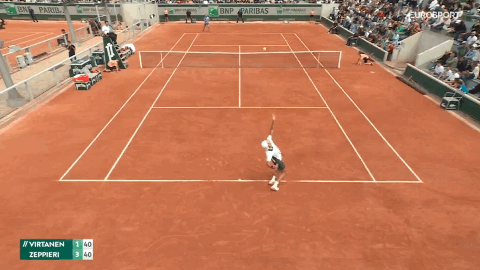
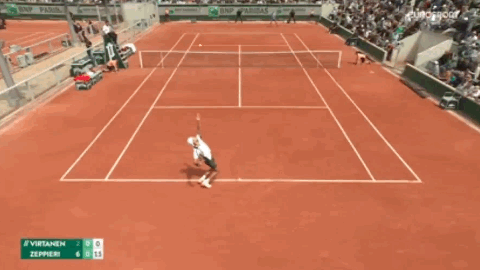
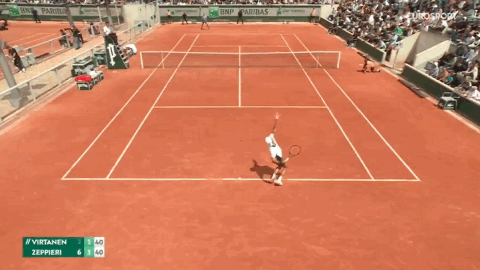
Giulio Zeppieri's point to 3-1* 40-ad (latest break point, 1st set) (top left), to *0-0 0-30 in the 2nd set (top right), and to 3-1* 40-ad in the 2nd set (bottom) (📸 Eurosport GB)
Despite having a subpar clay season and an underwhelming first part of the Asian Challenger swing on the hard courts beforehand, most of which was a result of his unserious mode coming out, except in some occasions where he was competitive enough despite the loss (e.g. in the second round of the Mauthausen Challenger against Max Hans Rehberg and the first qualifying round of the Turin Challenger against Marc-Andrea Huesler), O. Virtanen became even more serious during the Roland Garros qualification rounds, having a solid showing against Dane Sweeny 6-2, 6-3 and stunning the 11th seed Dominic Thiem 6-3, 7-5 in the Austrian's last-ever Roland Garros match. He faced a decent test in 31st seed Giulio Zeppieri, who, despite also his competitive early eliminations in most Challenger events he partook (most notably got defeated by Fabio Fognini 6-2, 6-3 in the first round of the Turin Challenger as a qualifier), he managed to regain his clay-court form in time as he defeated his fellow Italian Stefano Travaglia 6-3, 6-2 and survived trouble as he defeated Adrian Andreev 4-6, 7-5, 6-3 in another close encounter. Knowing both players, this should be one of those days where the more aggressive one would prevail in this match, but only those who could stay consistent in their range.
O. Virtanen started the match unseriously as his forehand errors resulted in G. Zeppieri breaking early to 1-0. Somehow, even with the Finn’s best efforts to save the break points, G. Zeppieri’s smash secured his latest break point before he doubled the break to 4-1, and he did not look back as he took the first set 6-2. Almost similarly, the Italian 31st seed started the second set with an early break due to O. Virtanen’s erratic showing, but the former had a forehand pass to O. Virtanen’s position at the net to generate his second break point before doubling the break in the same spot with the first set (fifth game). Consolidating his position with a service game hold (5-1), G. Zeppieri affirmed his dominance by also taking the second set 6-2, doing what he had to do to secure his spot in the main draw, just like when he became the first to qualify in the Australian Open this year.
Section 12: Gustavo Heide def. Matteo Gigante [28] 6-3, 6-2

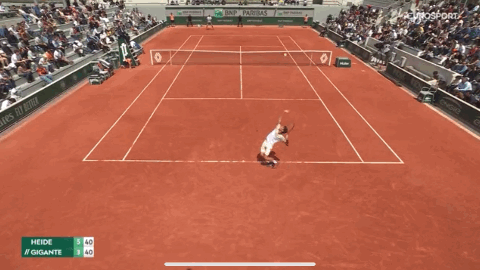

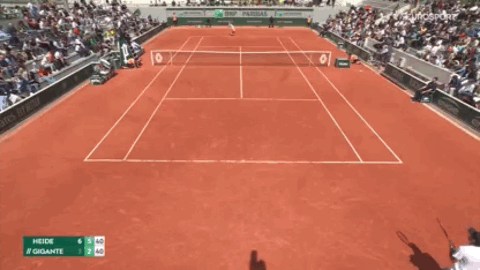
Gustavo Heide's points to 1-1* 40-40, 1st set (top left), to 5-2* 40-ad (set point-setting, 1st set, top right), to 5-2* 40-40, 2nd set (bottom left), and to 5-2* 40-ad, 2nd set (bottom right) (📸 Eurosport GB)
Trying to show the potential he has, M. Gigante came to this clay season prepared despite several rollercoasters, one of which was the Napoli Challenger quarterfinal against Luca Nardi, which he lost 6-4, 4-6, 1-6 while surviving the Marrakech qualification rounds as he defeated both Karim Bennani and Rudolf Molleker in 3 sets before having to retire down 3-6, 0-2 against Roberto Carballes Baena in the first round. This was also the case in this year's Roland Garros qualification rounds, as he had to survive two three-set matches against wild card Sacha Gueymard Wayenburg (6-4, 5-7, 6-4) and Dalibor Svrcina (4-6, 6-3, 7-5), coming back from a break down against the latter. In contrast, G. Heide came from his maiden Challenger title in Asuncion (d. Joao Fonseca 7-5, 6-7(6), 6-1) despite exiting in the second round in all his European clay campaigns (Mauthausen & Oeiras 4 Challengers), somehow navigating his way through the Roland Garros qualifying rounds after pulling a whole comeback against 12th seed Lukas Klein 1-6, 6-3, 7-6(5) and Bu Yunchaokete 7-5, 6-3 in a more convincing manner. This match could be a classic, decent test that showcased the best in them, with the more balanced player standing out in this match.
G. Heide commenced the match by breaking early to 2-1 as he outhit M. Gigante’s forehands while firing a working volley to secure the first deuce before the said break. He consolidated his lead to 3-1 and turned out to break for the first set (6-3) several games later after a backhand error fumbled M. Gigante’s break point, followed by his frequent forehand errors. Several games in, both players turned out to tussle for in total of 24 minutes including the first two games right after the Italian 29th seed forced the first deuce. By the conclusion of the third game, G. Heide had a massive hold to 2-1, which turned out to be crucial as he broke to 4-2 after a 0-hold due to M. Gigante’s frequent backhand errors and double faults (at least twice of the latter’s mistakes along the way). Without looking back, G. Heide strengthened his position with a service game hold to 5-2, constructing his break point through his preceding backhands after forcing a deuce through a backhand winner before taking the second set 6-2 due to M. Gigante’s forehand error, securing his maiden Grand Slam main draw appearance as he continued to rise this season.
Section 3: Mattia Bellucci def. Alejandro Moro Canas 3-6, 6-2, 7-6(7)
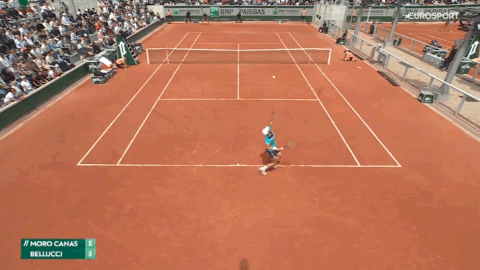
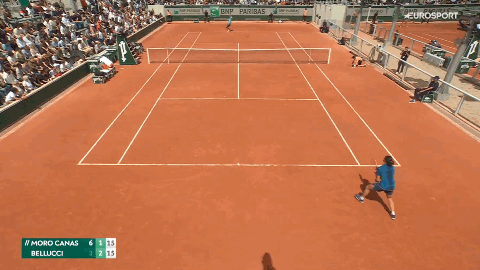
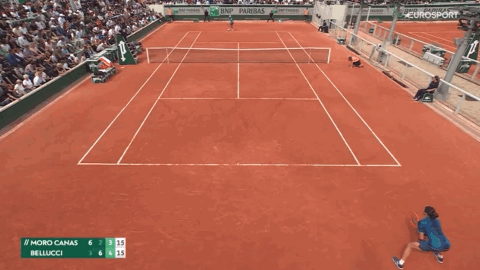
Mattia Bellucci's point to 5-3* 0-15, 1st set (top left), to *1-2 15-30, 2nd set (top right), and to *3-4 15-30, 3rd set (bottom) (📸 Eurosport GB)
A. Moro Canas came to the Roland Garros qualifying rounds completely in form, which started from his second-round loss against Taylor Fritz 6-3, 6-1 after stunning Dominic Thiem 6-4, 6-4 in the first round for his first-level ATP-level victory. Building up from there, he went on to win his maiden Challenger title in Rome (Italy), defeating his fellow first-time finalist Vilius Gaubas 7-5, 6-3 after denying the Lithuanian youngster the chance to serve for the first set, continuing this with a confident showing in the first two qualifying rounds as he defeated Marc Polmans 6-1, 6-2 and wild card Maxime Janvier 6-3, 6-4 to set a clash against Mattia Bellucci. In contrast, the Italian had an interesting approach, reaching the quarterfinals in the hard courts of the Shenzhen (Luohu) Challenger (l. James Duckworth) for his best showing in the first part of the Asian Challenger swing before returning to Europe, starting his clay season in the Turin Challenger qualifying rounds as he defeated Alexis Galarneau 6-7(3), 6-3, 6-2 after a scrappy start only to be defeated by an in-form Francesco Maestrelli 6-3, 6-2 in the first round. He followed this up by defeating Matteo Martineau 3-6, 6-1, 6-1 and stunning 20th seed Lloyd Harris 6-1, 7-6(9) after recovering from a 1-4 deficit in the tie-breaker and surviving a set point, setting this encounter that could come down to their pressure points’ handling despite their fiery groundstrokes at their best. Indeed, the match did not disappoint, it had everything.
As A. Moro Canas dominated the first set through his powerful aggression, taking the first set 6-3 while surviving the Italian’s backhand pass in hopes of prolonging the said set, M. Bellucci steadily struck back from the baseline, which pressed A. Moro Canas’ second serves enough for the Spaniard to commit a double fault to be broken (1-3). M. Bellucci then consolidated his lead to 4-1 and ended up going after A. Moro Canas’ forehands, which assisted him in breaking for the second set 6-2. The deciding set turned out to play a big role as both players upped their aggression against each other and struck the ball as cleanly as possible, as well as displaying their stellar point constructions in between. This included M. Bellucci’s notable drop shot for a one-point lead even if it was neutralized through a backhand pass, where the Italian held his service game to 4-3 even if he had to survive a break point back in the sixth game. With A. Moro Canas holding his service games to 6-6, a match tie-break occurred to determine the rest of the match, where the former was unable to capitalize on his 4-2 lead (which happened due to M. Bellucci’s double-fault right at the first point of the breaker), followed by a volley error. Subsequently, A. Moro Canas’ forehand error, which was fired too long, generated M. Bellucci’s mini-break to 6-5, and even though he had a match point saved earlier, an unreturned serve converted the match point as M. Bellucci took the third set 7-6(7), thus securing his spot in the main draw.
Section 10: Gregoire Barrere [10] def. Denis Kudla 3-6, 6-2, 6-3
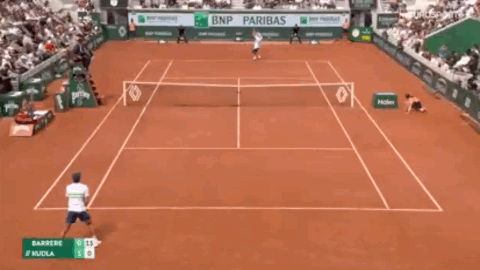
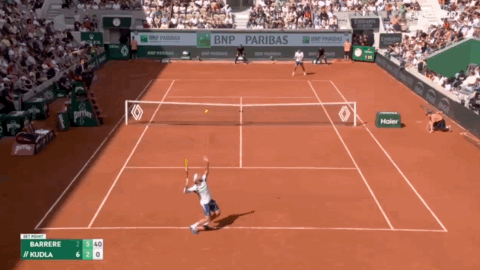
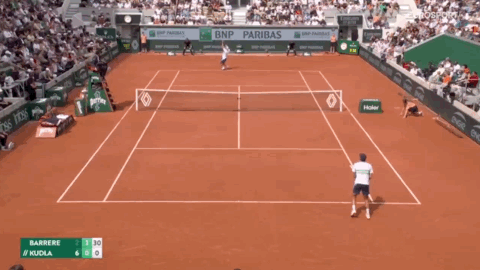
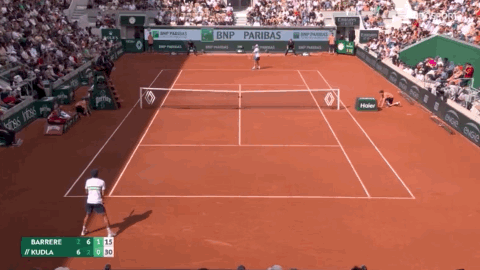
Gregoire Barrere's points to 0-1* 0-30, 1st set (top left), 1-0* 0-40, 2nd set (top right), to take the 2nd set 6-2 (bottom left), and to 1-0* 30-30, 3rd set (bottom right) (📸 Eurosport GB)
G. Barrere might have had a slow start to the season back on the hard courts, but the clay season turned out to be a perfect moment for him to bounce back from these setbacks. Most notably, he reached the semifinals of Bucharest (250) (l. Mariano Navone) and Aix-en-Provence Challenger (l. Arthur Fils), defeating wild card Theo Papamalamis 6-3, 6-1 and Andrea Pellegrino 6-2, 3-6, 6-4 coming to the Roland Garros third qualifying round. On the other hand, outside of the San Luis Potosi Challenger semifinal, it was a subpar clay-court campaign for Denis Kudla before suddenly goating in the French Open qualifying rounds, as he defeated other clay-court frequents Jan Choinski 6-4, 6-4, and 19th seed Vit Kopriva 3-6, 6-3, 6-3 in the first two qualifying rounds. As the more aggressive one from the said two players took this, this ended up testing their range consistency when the match allowed, especially with such pacing.
Even though this match started with D. Kudla suddenly peaking through his passes, G. Barrere had a notable backhand down-the-line winner to win the second point of the second game (in the first set) in hopes of breaking back, but to no avail even if he had several break points as D. Kudla held his serves to 2-0, and turned out to dominate the flow as he doubled the break and took the first set 6-2. However, G. Barrere regrouped after he held the first game of the second game, creating his break point with a volley before he broke to 2-0. Even if he got broken back right after as D. Kudla leveled the play (2-1), G. Barrere went after D. Kudla’s forehands to break again to 4-2, topped by the American’s double-fault. By then, G. Barrere broke again for the second set thanks to his backhand to D. Kudla’s slice error as he targeted D. Kudla’s forehands midway. The French 10th seed then emphasized the importance of his setup as his preceding backhand equalized the play in the fourth point of the second game (1-0* to 30-30) before D. Kudla’s two consecutive double faults secured the former’s break of serve (2-0). Since then, G. Barrere did not look back, strengthening his lead to 3-0 while almost demolishing D. Kudla as he forced the deuce in the fourth game. Ultimately, even if D. Kudla held his service games, it was insufficient to put more pressure on G. Barrere as the Frenchman took the 3rd set 6-3, confirming his resurgence with a main draw spot in his home Slam.
Section 9: Gabriel Diallo def. Alexander Ritschard 3-6, 6-2, 6-3




Gabriel Diallo's point to 2-1* 40-ad (earlier break point, 2nd set, top left), to 5-2* 0-40 in the 2nd set (top right), to 1-2* 30-40 (3rd break point, 3rd set, bottom left), and 3-2* 30-40 (1st break point, 3rd set, bottom right) (📸 Eurosport GB)
This clash might have been overlooked on paper as several other names were favored instead, but they proved that nothing is impossible. Gabriel Diallo built his rally tolerance a long way despite his loss to Mitchell Krueger in 2 tie-break sets back in Houston (250), fighting his way despite his elimination to eventual champion Thanasi Kokkinakis 6-7(3), 6-4, 6-7(3) in a 3-hour-30-minute battle, and displaying it as well in the first round of the Mauthausen Challenger before he had to retire down 6-3, 5-7, 2-4 against Lukas Neumayer. Interestingly, as he also defeated some clay-court frequents along the way, which included Orlando Luz and Hugo Dellien in the Turin Challenger qualifying rounds, he also dug deep to defeat Argentineans Genaro Alberto Olivieri 7-5, 6-7(4), 6-1 and Marco Trungelliti 7-6(6), 3-6, 6-4 in the first two qualifying rounds in Roland Garros. On the other hand, A. Ritschard had an intriguing United States clay campaign, as he qualified for the Houston (250) before being defeated by J.J. Wolf in the first round and went on to win the Savannah Challenger after defeating qualifier Andres Andrade 6-2, 6-4 for the first time since the Hamburg Challenger 2022, going straight to the Roland Garros qualifying rounds by confidently stunning the Oeiras 4 Challenger runner-up, Elias Ymer, 6-2, 6-1, and Titouan Droguet 6-1, 6-3 in the first two qualifying rounds. For either player, this could be all to play for, showcasing everything they got in terms of their point construction and some balanced plays for a spot in the main draw.
In the first set, G. Diallo struggled with forehand errors, allowing A. Ritschard to break early (1-0) and take a 2-0 lead. The same forehand error resulted in A. Ritschard’s double-break lead, where he eventually took the first set 6-2. Nonetheless, the Canadian started to hit the ball even harder, smashing it to generate his third break point before finally breaking to 3-1 due to A. Ritschard’s forehand error, and held his service game afterward to 4-1. Ultimately, G. Diallo forced the deciding set as he broke to 6-2, getting broken early moments after he double-faulted in the fourth game of the first game to start the third set. The Canadian returned from the brink by becoming more offensive, breaking back to 2-2 before doing it again to 4-2 as his forehand winner generated his first break point, eventually taking the 5-2 lead. Two games later, after overcoming a couple of deficits, G. Diallo served for the match (6-3) and secured his first appearance in a Grand Slam-level main draw. This win showcased improvements in his rally tolerance and pacing on red clay. Interestingly, the final scoreline coincidentally matched that of a previous match in Section 10.
#atp world tour#atp tour#grand slam#french open#roland garros#roland garros 2024#tennis updates#hot shots#break point#hamad medjedovic#geoffrey blancaneaux#shintaro mochizuki#facundo bagnis#valentin vacherot#billy harris#giulio zeppieri#otto virtanen#gustavo heide#matteo gigante#mattia bellucci#alejandro moro canas#gregoire barrere#denis kudla#gabriel diallo#alexander ritschard#know your qualifiers
0 notes
Text
Pan American Games 2023 (Day 4)

Men’s singles third round
[6] Gustavo Heide (BRA) def. Justin Boulais (CAN) 6-3, 6-3
Mixed doubles quarterfinals
[1] Marcelo Demoliner (BRA) / Luisa Stefani (BRA) def. Justin Boulais (CAN) / Rebecca Marino (CAN) 6-4, 3-6, [10-7]
(Picture : © Tennis Canada)
0 notes
Text
🎾 Medalla de oro para Dïaz Acosta en single
🎾 #Odesur #Tenis - Medalla de oro para Dïaz Acosta en single...
Facundo Diaz Acosta se llevó la medalla de oro en el torneo individual masculino de tenis de los XII Juegos Suramericanos Asunción 2022, que se disputa en las canchas de polvo de ladrillo del complejo de la Secretaría Nacional de Deportes, al vencer, en la final, al brasilero Gustavo Crozariollo Heide por 7-5 y 7-5. (more…)

View On WordPress
0 notes
Text
A história da mulher que viajou 11 mil km e matou coronel para vingar Che Guevara
Nascida em Munique, em 1937, Monika Ertl era filha do cineasta, escritor, jornalista e alpinista Hans Ertl, que trabalhou com a diretora de cinema Leni Riefenstahl — foram amantes — e chegou a ser cinegrafista do nazista Adolf Hitler (filmou seu encontro com Benito Mussolini, o fascista italiano) e andou com Erwin Rommel pelo Norte da África. Em 1953, julgando-se desprestigiado na Alemanha, mudou-se com a família — a mulher, Aurelia, e três filhas, Monika, Beatrix e Heide — para a Bolívia.

O jornalista americano Jon Lee Anderson escreveu um livro alentado sobre o revolucionário que, ao lado de Fidel Castro, foi um dos principais líderes da Revolução Cubana de 1959. “Che Guevara — Uma Biografia” (Objetiva, 920 páginas, tradução de M. H. C. Côrtes) é uma autêntica “bíblia” sobre o guerrilheiro argentino. A edição, de 1997, não contém ao menos uma menção à alemã Monika Ertl. Mas sua vida é fascinante, tanto que o cineasta greco-francês Costa-Gravas, de 85 anos, planejou filmar sua vida, com Romy Schneider como atriz principal. Autor do livro “La Mujer Que Vengó al Che Guevara — La Historia de Monika Ertl” (Capital Intelectual, 293 páginas, tradução de Florencia Martin), o jornalista alemão Jürgen Schreiber sugere que, para fazer Roberto (“Toto”) Quintanilla Pereira, o ator ideal seria o francês Alain Delon. (A obra não tem tradução brasileira.)

Nascida em Munique, em 1937, Monika Ertl era filha do cineasta, escritor, jornalista e alpinista Hans Ertl, que trabalhou com a diretora de cinema Leni Riefenstahl — foram amantes — e chegou a ser cinegrafista do nazista Adolf Hitler (filmou seu encontro com Benito Mussolini, o fascista italiano) e andou com Erwin Rommel pelo Norte da África. Em 1953, julgando-se desprestigiado na Alemanha, mudou-se com a família — a mulher, Aurelia, e três filhas, Monika, Beatrix e Heide — para a Bolívia. Em La Paz, tornou-se amigo de Klaus Barbie, o “carniceiro de Lyon”. Tanto ela quanto o pai parecem personagens de ficção — quiçá de Graham Greene, John le Carré e, até, de García Márquez.
Na Bolívia, Hans Ertl, com o apoio de Monika Ertl, fez filmes, mas acabou isolando-se na sua fazenda, La Dolorida. Monika Ertl casou-se com Hans, um engenheiro rico, mas não era feliz. Quando Hans perguntou-lhe: “Quer ser minha mulher?” Já rebelde, a jovem redarguiu: “Preferia ser sua amante”. Havia sido professora no Instituto Goethe de La Paz e era leitora do escritor alemão Hermann Hesse, ganhador do Prêmio Nobel de Literatura de 1946.
Ao fazer trabalho social com crianças, na Bolívia, e depois de circular na Alemanha com estudantes de extrema esquerda, Monika Ertl começou a se interessar pelas ideias de Ernesto Che Guevara — que havia sido morto, em 9 de outubro de 1967, pelo governo boliviano. Ela apreciava as ideias da Teologia da Libertação.

Doutrinada por integrantes do Ejército de Liberación Nacional (ELN), de linhagem guevarista, Monika Ertl se aproximou de Guido “Inti” (“Sol” em quéchua) Peredo, que havia lutado com Che Guevara (era um dos cinco sobreviventes do “exército” cubano-boliviano). Era um dos favoritos do líder guerrilheiro. Adotou o nome de “Imilla” (significa “menina indígena”).
Apaixonada por Inti Peredo, tornou-se uma guerrilheira exemplar (entrou para o ELN em 1969). Disse aos companheiros que não temia cair “como um soldado” e “estava disposta a morrer pela causa” comunista.
Morte de Inti
Inti Peredo, o Guevarinha da Bolívia, era um ideólogo de família proeminente, doutrinado e treinado militarmente em Cuba. Com a morte de Che Guevara, assumiu o comando do ELN. Seus irmãos, Coco e Chato (formado em Moscou), também eram guerrilheiros.
Che Guevara sublinhava que Inti Peredo tinha grande valor físico e moral, não era um mero tarefeiro. Ele continuou a luta, avaliando mal a correlação de forças. Em 9 de setembro de 1969, traído por um militante do Partido Comunista (comprado por 4 mil dólares) e encurralado no bairro El Rosario, é morto por militares e policiais coordenados pelo ás do Serviço Secreto da Bolívia, Roberto Quintanilla. “Nesse dia, Quintanilla irrompeu, de maneira decisiva, na vida de Monika Ertl. Havia matado Inti justo numa das poucas vezes em que ele não dormiu na sua casa”, relata Jürgen Schreiber.

Terminada a batalha, autêntico “banho de sangue”, Roberto Quintanilla “posa junto ao corpo de Inti Peredo”. Mesmo sendo um homem da Inteligência do governo, não soube permanecer no anonimato e atraiu a fúria da esquerda. “No dia em que quis converter-se em uma figura imortal passou a ser um homem morto.”
Roberto Quintanilla já era odiado pela esquerda mundial porque teria sido o agente que sugeriu que as mãos de Che Guevara fossem cortadas para comprovar que se tratava mesmo do guerrilheiro argentino. Cuba lançou a “maldição do Che”. Aqueles que contribuíram para a execução de Che Guerra deveriam ser mortos. “A maldição lançada por Fidel recaiu”, de maneira mais acintosa, sobre o coronel. “O vencedor pagará com a vida”, teria dito Fidel Castro. O ELN proclamou “¡Victoria o Muerte!” “Nenhum culpado morrerá na cama”, bradou o Exército de Libertação Nacional.
O ELN estava quase tão morto quanto Che Guevara e Inti Peredo. Mas Chato Peredo e outros ativistas decidiram reorganizá-lo, mais uma vez sem entender que a correlação de forças não lhes era favorável. Jürgen Schreiber ressalta que, sob o comando do irmão de Inti Peredo, o ELN se perde. No conflito com militares e policiais, quase 60 guerrilheiros foram “sacrificados”, frisa o jornalista. O governo boliviano chegou a usar napalm (o que não havia feito contra Che Guevara). Os chefes da esquerda justiçaram aqueles que consideravam como traidores.
Crime e Feltrinelli
A cúpula do ELN escapa para o Chile do presidente socialista Salvador Allende. Lá, Chato Peredo apaixona-se por Monika Ertl e o ELN, em conluio com Cuba, planeja o assassinato de Roberto Quintanilla. Matar o coronel significaria provar que o ELN estava ativo.
A participação de Monika no assassinato de Roberto Quintanilha tem duas explicações. A política é que, sendo uma militante disciplinada, tinha de cumprir a determinação do grupo político ao qual pertencia, o ELN (bancado por Cuba). A emocional é que o coronel havia articulado o assassinato do amor de sua vida, Inti Peredo. Matá-lo era uma vingança política e afetiva. Ela se considerava sua “viúva”. A jovem de 33 anos “era capaz de fazer qualquer coisa por Inti”. Escreveu o poema “Cristo de Setembro” sobre o parceiro. O outro ídolo da revolucionária era Che Guevara (identificava-se com sua crítica ao imperialismo), também morto por homens de Quintanilla. Os dois eram vistos como “sacrossantos”.

Jürgen Schreiber assinala que a “paixão” de Monika Ertl por Inti Peredo foi “fatal” e sua “paixão” contra Roberto Quintanilha, impiedosa. Ao circular com esquerdistas alemães, ela dizia sobre o homem que admirava e amava: “Uma pessoa importante, um grande revolucionário”. O manifesto “Voltaremos às Montanhas”, escrito por Inti Peredo, havia sido traduzido na Alemanha. O jornalista sustenta que a bela guerrilheira seguia as “escrituras” de Che Guevara e Mao Tsé-tung (a esquerda da Alemanha Ocidental o tratava como deus) de modo dogmático.
Na Alemanha, Monika descobre um novo amor, Reinhard H., irmão de seu ex-marido. Ele também era de esquerda. O conselho de mulheres da União Socialista Alemã de Estudantes (SDS) contribuiu para ampliar a militância esquerdista da jovem, mas teria sido um cubano da embaixada de Londres quem teria aberto as portas do ELN para a jovem. Ela mantinha ligação com a Fração do Exército Vermelho da Alemanha Ocidental (capitalista) e com a Comuna Babeuf.
O assassinato
Chato Peredo conta que Monika foi escolhida para matar Roberto Quintanilha, que havia sido enviado à Alemanha — era cônsul-geral em Hamburgo (o objetivo era protegê-lo) —, porque falava alemão fluentemente e não despertaria suspeitas. Era, afinal, uma alemã visitando a Alemanha Ocidental (o país não estava unificado). Antes, o serviço secreto de Fidel Castro havia treinado dois irmãos venezuelanos para assassinar o coronel, mas, dados os riscos, abortaram a ação. Eles já estavam na Áustria.
Excelente atiradora — havia aprendido com o pai —, Monika Ertl queria matar Roberto Quintanilha. Era uma mulher de uma coragem inaudita. O francês Régis Debray escreveu que “nunca tinha medo”. O planejamento do assassinato se deu na Bolívia, Chile, Cuba, Dinamarca, Itália, Londres, Alemanha e Suíça. A embaixada cubana em Londres deu informações sobre o trabalho do cônsul em Hamburgo (ele estava na cidade desde julho de 1970). Aos aliados, a guerrilheira disse que planejava acabar com as “maquinações” do governo militar boliviano. “Monika havia selado um pacto com o ELN que não tinha volta, sua vida anterior havia deixado de ser real”, anota Jürgen Schreiber.

O líder-chave por trás do assassinato de Roberto Quintanilla é o cubano Fidel Castro, que usou seus agentes, como o italiano Giangiacomo Feltrinelli — editor das obras-primas “Doutor Jivago”, de Boris Pasternak, e “O Leopardo”, de Tomasi di Lampedusa —, o jornalista e escritor dinamarquês Jan Stage, o boliviano Chato Peredo (chefe do ELN) e o argentino “o gordo Carlos”, para financiar e oferecer logística para a ação de Monika Ertl. Dois homens de Fidel Castro, Manuel Barbarroja Piñeiro, o James Bond do Caribe, e Ángel Gustavo Brugués, da Inteligência de Cuba, atuaram como operadores. O Serviço Secreto Cubano, o ELN, os Grupos de Ação Partisan (GAP), dos quais participava Feltrinelli e a extrema esquerda alemã coordenaram, direta ou indiretamente, o crime. Embora dirigido por Cuba, o assassinato teria sido articulado primeiramente no Chile, no parque de uma universidade de Santiago.
Decidido que Monika Ertl seria a assassina de Roberto Quintanilla, a rede de espiões, tanto em Londres — a embaixada cubana era um celeiro de agentes — quanto na Alemanha, começou a municiá-la de informações. O consulado boliviano fica num bairro tranquilo de Hamburgo, na Heilwigstrasse 125. Curiosamente, embora não tenha interessado à polícia, militantes da esquerda alemã, uma comuna, vivia no mesmo edifício. O Serviço Secreto Cubano, organizado por Markus Wolf, da Stasi, a polícia secreta da Alemanha Oriental, proclama: 1969 é o “ano do esforço decisivo”. Era a determinação para matar o homem que havia “vilipendiado” Che Guevara e Inti Peredo.
Ao viajar para a Europa, para cumprir sua missão, Monika Ertl possivelmente usava passaportes falsificados pelo Serviço Secreto Cubano. “É possível que a guerrilheira tenha aprendido em Cuba técnicas de luta corpo a corpo e outras coisas”, diz Jürgen Schreiber.
Radical chic e milionário, Feltrinelli não se contentava em financiar grupos políticos de extrema esquerda. Participava de atos terroristas e explodiu a si próprio, em 1972, quando tentou cometer um atentado. Era, segundo cubanos, um dos principais agentes de Fidel Castro (e dos palestinos) na Europa (o editor havia sido treinado como agente em Cuba e na Tchecoslováquia).
Instado a participar da operação, como financiador, para assassinar Roberto Quintanilla, o editor aproximou-se de Monika Ertl — com quem, supostamente, teve um caso. Ela admirava seu charme aristocrático e ele admirava a revolucionária intimorata. O milionário de Milão esteve em La Paz, estabelecendo relações com militantes do ELN, mas acabou preso por policiais dirigidos por Roberto Quintanilla. No Brasil, o notável editor apoiou a Ação Libertadora Nacional, de Carlos Marighella. Até o cineasta italiano Luchino Visconti teria dado apoio à ALN.

Manuel “Barbarroja” Piñeiro ordena que Feltrinelli e Jan Stage criem a estrutura adequada para Monika Ertl matar Roberto Quintanilla. Do Chile, a guerrilheira segue para a França. Num barco, Feltrinelli entrega-lhe um Colt Cobra 38 Special (de origem americana). Espantosamente, era uma arma comprada no mercado legal e registrada no nome do editor, o que, mais tarde, levou à sua identificação.
A viagem de Monika Ertl para Hamburgo pode ter sido financiada por Feltrinelli. Uma soma elevada teria sido entregue por Jan Stage a Chato Peredo (há até recibo assinado pela guerrilheira). É provável que, como agente de Fidel Castro, o editor estivesse monitorando a assassina de Roberto Quintanilla (num período, ela chegou a criticar Cuba: “Uma demência, um passatempo chamado revolução”. A ligação de Cuba com a União Soviética desagradava Che Guevara; o país de Lênin, Stálin e Nikita Kruchev seria imperialista).
Inicialmente, como havia sido sargento e sabia atirar, Jan Stage chegou a ser cotado para matar o cônsul. Porém, por vontade própria, quase uma exigência, Monika Ertl decidiu que o papel era seu.
Jan Stage pode ter acompanhado Mônica Ertl ao sul da França para pegar o Colt Cobra com Feltrinelli. No dia 1º de abril de 1971, o do assassinato de Roberto Quintanilha, o dinamarquês estava em Hamburgo.
No dia 25 de março, uma mulher ligou e disse que iria ao consulado para buscar informações e imagens sobre o folclore da Bolívia.
Já no consulado, Monika Ertl conversou com Roberto Quintanilla, que parece ter ficado impressionado com sua beleza (tinha corpo e rosto de modelo) — apesar de ter pressentido que havia alguma coisa errada. Ele pediu à secretária que passasse folhetos para a “turista”. Ao sair da sala, dirigindo-se ao corredor, foi seguido, levou três tiros e caiu. Sua mulher, Anna Quintanilla, lutou com Monika Ertl e derrubou o revólver. Na refrega, caíram a peruca, o revólver, botões de um casaco, uma toalha de mão, óculos e uma jaqueta. A guerrilheira cumpriu seu objetivo, ao matar o coronel, mas agiu com certo amadorismo.
Aos 43 anos, o cônsul só conseguiu dizer a Anna Quintanilla: “Cuide dos meninos!”. Chegou a ser atendido por médicos, mas não resistiu.
Jürgen Schreiner diz que, “até o dia de hoje [seu livro saiu na Alemanha em 2009], não se sabe como” Monika Ertl “chegou à cena do crime” e desapareceu “sem deixar rastros”.
Monika viajara 11 mil quilômetros para matá-lo. “A morte de Quintanilla numa cidade tão distante de seu lugar de origem tinha o propósito de chamar a atenção para os assassinatos e torturas cometidos pelo governo boliviano” — uma ditadura cruenta — e, claro, era uma vingança contra o coronel que havia contribuído para matar Che Guevara e Inti Peredo.
Fuga de Monika
A polícia de Hamburgo revelou que Jan Stage dirigiu o automóvel em que Monika Ertl escapou da embaixada. Anna Quintanilla afirmou que a guerrilheira saiu pela porta da frente do consulado. A secretária corroborou a informação. Mas acrescentou: “Não sei como a mulher pôde abandonar a Heilwigstrasse tão rapidamente”. Poderia ter saído pela porta traseira. Ela pode ter se escondido na comuna que existe no mesmo edifício? É uma possibilidade, um golpe de mestre. Porque, apesar de a polícia vasculhar o bairro, nada encontrou.
Cometido o atentado, Monika Ertl vai para o Chile de Allende e, rapidamente, para Cuba. Temia ser assassinada. Entretanto, contrariando todas as advertências — “era a mulher mais caçada da Bolívia” —, volta para a Bolívia pouco depois. O ELN estava se retirando da luta e ela retornava para comandar um exército fantasma. Passou a ser a cabeça do Exército de Libertação Nacional. Os líderes da organização estavam à salvo no Chile e em embaixadas estrangeiras. “Na pior fase da ditadura de [Hugo] Banzer, ela ficou ali, presente. É ‘um exemplo de coragem revolucionária e entrega absoluta pela causa’, proclamam seus companheiros”, registra Jürgen Schreiber. Ela imprime e distribui o periódico clandestino “El Inti”. “Era como bailar em cima de um vulcão.”

O codinome de Monika Ertl era, além de Imilla (demonstra sua identificação com as lutas dos bolivianos), Nancy Fanny Miriam Molina — seria argentina. Circulava disfarçada pelas ruas da Bolívia, notadamente em La Paz (companheiros não conseguiram retirá-la do país). Mas o serviço secreto a monitorava, esperando a hora certa para capturá-la. Na Rua Entre Ríos, em La Paz, paramilitares (com o suposto apoio de Klaus Barbie) a cercaram e, no 12 de maio de 1973, a mataram (morreu em questão de segundos). Ao seu lado, foi executado o argentino Osvaldo Ucasqui. Ela tinha 35 anos e chegou a reagir, mas estava isolada, sem saída. A espiã que a delatou recebeu 20 mil dólares (a oferta para entregar Che Guevara era de 4.200 dólares). O governo boliviano não entregou o cadáver da guerrilheira à sua família. Seu pai morreu, em 2000, aos 90 anos.
Jürgen Schreiber pergunta: Monika Ertl “pagou com sua vida um autoengano colossal?” Inspirando-se em Cuba, na luta que começou em Sierra Maestra, os líderes e militantes do ELN acreditaram que poderiam fazer o mesmo na Bolívia. Mas havia uma diferença crucial. Na Bolívia, a ditadura, em plena Guerra Fria, tinha o apoio militar e financeiro dos Estados Unidos. Os militares que caçaram e mataram Che Guevara haviam sido treinados por boinas-verdes americanos e a área de Inteligência foi qualificada pela CIA. Os guerrilheiros não tinham o apoio da população — estavam isolados — e a mínima estrutura para vencer e abalar o governo dos militares bolivianos. Neste sentido, talvez seja possível responder positivamente: o autoengano de Monika Ertl e seus aliados foi colossal. Uma espécie de suicídio político e militar.
Segundo Jürgen Schreiber, Monika Ertl queria ser uma “heroína da liberdade”. A alemã, que não era ideóloga, acreditava na construção de um mundo justo, quer dizer, comunista. Era mais identificada com o radicalismo de Che Guevara — devoto do foquismo e da revolução permanente (embora não fosse trotskista) — do que com a realpolitik de Fidel Castro (aliados dos soviéticos).
Guimarães Rosa
No final do livro, Jürgen Schreiber escreve: “Para retardar o processo de decomposição, injetaram formaldeído [no corpo de Che Guevara]. E então seus olhos voltaram a abrir como se ele quisesse observar seus assassinos. Os livros dedicaram suas páginas à lenda: um cadáver que voltava a abrir os olhos pronto sairia em busca de outro” cadáver [“un cadáver que volvía a abrir los ojos ‘pronto’ saldría em busca de otro” — é uma referência a Roberto Quintanilla], leio nas novelas de João Guimarães Rosa, ex-cônsul-geral do Brasil em Hamburgo. Assim aconteceu com seu colega boliviano” (Roberto Quintanilla). A citação ao autor do romance “Grande Sertão: Veredas” não me parece oportuna, mas, como não sou especialista na sua obra, não tenho como contrapor ao que escreve o jornalista.
“As três seguidoras mais conhecidas do Che são alemãs. Tamara Bunke Bider, de Berlim Oriental [teria nascido na Argentina], e a estudante de Arquitetura de Gotinga [Göttingen], Jenny Koehler, também pagaram sua defesa do ELN com suas vidas”, revela Jürgen Schreiber. A terceira foi Monika Ertl. A história de Tamara Bunke Bider pode ser conferida no excelente livro “Tamara, Laura, Tânia — Un Misterio en la Guerrilha del Che” (Del Nuevo Extremo, 435 páginas), do economista e professor universitário Gustavo Rodríguez Ostria, por sinal, uma das fontes do livro de Jürgen Schreiber.
O escritor boliviano Rodrigo Hasbún escreveu um romance sobre a história da família de Monika Ertl — “Os Afetos” (Intrínseca, 128 páginas, tradução de José Geraldo Couto). Há um documentário sobre a guerrilheira: “Procurada — Monika Ertl”, de Christian Baudissin. Régis Debray escreveu um romance sobre a revolucionária alemã: “La Neige Brûle” (“La Nieve Quema”).
A história da mulher que viajou 11 mil km e matou coronel para vingar Che Guevara Publicado primeiro em https://www.revistabula.com
4 notes
·
View notes
Text
Campeonato de España (Badajoz) FEFF (resultados)
Campeonato de España de resultados (Badajoz) FEFF biomarcadores , evento celebrado los días 14 y 15 de octubre en IFEBA en Badajoz.
Campeonato de España (Badajoz) FEFF 2017 Master Classic culturismo resultados
1. Manuel Sanchez Mira (Comunidad Valenciana) (5)
2. Antonio Hernandez Parra (Murcia) (8)
3. Juan Francisco Rojas García (Comunidad de Madrid) (2)
4. Pedro Fuentes Crespo (Castilla y León) (6)
5. Plumas redondas de Vicenç (Katalonia) (7)
6. Ramón Fallas Berrocal (Katalonia) (3)
. Jordi Valls (Katalonien) (4)
Bodyfitness Senior hasta 158 cm
1. Anabel Da Cruz Valenzuela (Katalonia) (98)
2. Meire Alves Da Silva (Katalonia) (102)
3. Rocío Ibáñez García (La Rioja) (88)
4 Sarah-Ashleigh Baker (Andalucía) (93)
5. Lucia Castillo Sanchez (Comunidad de Madrid) (109)
6. Maria Isabel Fernandez Fernandez (Galicia) (119)
. Alba Brox García (Comunidad de Madrid) (110)
Bodyfitness senior exige 163 cm
1. Elena Eulalia Ordoñez Mendez (Extremadura) (104)
2. Zaira Serrano Alama (Andalucía) (92)
3. Anna Ferrer Flos (Cataluña) (89)
4. Iune Gonzalez Ojembarrena (Cataluña) (118)
5. Rafaela Silva (Cataluña) (115)
6. Isabel Mendiola Torrón (Madrid en su totalidad) (99)
. Sara Rodríguez Berza (Galicia) (96)
. Montserrat Celaya Ramírez (Katalonia) (100)
. Cristina Rodriguez Olmos (Comunidad Valenciana) (103)
. Nuria Sans Roselló (Katalonien) (105)
. BegoñGarcia Villarraco (Comunidad Valenciana) (107)
. Luisa Gil Serrato (Baleares) (108)
. Mirian Ramos Caceres (Andalucía) (118)
Bodyfitness Senior hasta 168 cm
1. Marisa Lobato Gutierrez (Andalusia) (114)
2. Marina Navas Campaña (Comunidad de Madrid) (120)
3. Laura Benasques Borau (Katalonia) (122)
4. Mihaela Loredana Caiuteanu (Canarias) (116)
5. Pino Leon Yamila (Canarias) (94)
6. Guadalupe Quiles Robles (Comunidad Valenciana) (95)
. Silvia Tambo Arizcure (Comunidad de Madrid) (97)
Bodyfitness Senior plus 168 cm
1. Raquel Arranz Fernandez (Galicia) (117)
2. Sjoukje Van Der Heide (Andalucía) (112)
3. Helena Castro Roman (Andalucía) (90)
4. Montserrat Celaya Ramírez (Katalonia) (101)
5. Veronica Martin Martin (Comunidad de Madrid) (91)
6. Soraya Alvarez Peñuela (Asturia) (106)
. Sonia Trapero Burgos (La Rioja) (121)
Campeón absoluto de bodyfitness
Raquel Arranz Fernandez (Galicia) (117)
Bikini Fitness Junior
1. Elena Maria López Baena (Andalucía) (12)
2. Rocio Araujo Carrasco (Asturias) (20)
3. Sonia Bierge De Juan (Cataluña) (18)
4. Rosa Lopez Alamo (Andalucía) (11)
5. Tatiana Mompean Guillen (Comunidad Valenciana) (21)
6. Georgina Rivas Vilanova (Katalonien) (15)
. Ana Amante Gregorio (Murcia) (9)
. Paola García CéSpedes (Andalusia) (10)
. Raquel Frias Martinez (Cataluña) (13)
. Estefania Robles Rodriguez (Comunidad Valenciana) (14)
. Pilar Fernandez Jaen (Extremadura) (16)
. belén Gutiérrez Martín (Castilla y León) (17)
. Raquel Gonzalez Adan (Canarias) (19)
Bikini Fitness Master hasta 163 cm
1. Sonia Rodriguez Martin (Cataluña) (131)
2. Rebeca Mena Serrano (Cataluña) (129)
3. Kamila Pardamcova (Andalucía) (140)
4. Rocio Pedrero Rivera (Andalusia) (128)
5. Tamara Iglesias Elvira (Comunidad de Madrid) (139)
6. Gloria Borregales Simancas (Comunidad de Madrid) (127)
. Karina Balladares De Larramendi (Galicia) (130)
. Irene Carrasco Rojas (Euskadi) (133)
. Maria Del Rosario Guillen (Murcia) (136)
Bikini Fitness Master plus 163 cm
1. Valeria Noel Britos (Cataluña) (132)
2. Sandra Cortés Román (Cataluña) (138)
3. Rocio Feria González (Andalucía) (135)
4. Sarahy Gonzalez Hernandez (Canarias) (137)
5. Raquel Heras Bohajar (Comunidad Valenciana) (143)
6. Sonia Gomez Baeza (Galicia) (125)
. Marta Guijaro Rojas (Comunidad de Madrid) (126)
. Vanesa Carrera Pérez (Euskadi) (134)
. Irene Ibañez Martin (Comunidad de Madrid) (141)
. Marzo Verónica Vilas Faggiotto (Andalucía) (142)
. Virginia Borrego Fernandez (Andalucía) (144)
El maestro absoluto de Bikini Fitness Master
Valeria Noel Britos (Cataluña) (132)
padre físico masculino hasta 170 cm
1. Alejandro Cerrejón Torrano (Murcia) (33)
2. Julián Francisco Marín Celdran (Murcia) (53)
3. Juan Guillermo Ballesteros Cebrian (Andalusia) (73)
4. Michael Anthony Bosca Sanchez (Cataluña) (36)
5. Jonathan Alvarez Rodriguez (Asturias) (30)
6. Joel Nogal Fernández (Comunidad de Madrid) (74)
. Jose Antonio Afonso Luis (Canarias) (23)
. Aitor Alfonso Vivas (Euskadi) (25)
. Antonio Fernando Abellon Jimenez (Murcia) (37)
. Jose Antonio Chacon Guerrero (Andalusia) (39)
. Kiko Antonov (Comunidad Valenciana) (46)
. Angel Pintor Cencerrado (Comunidad Valenciana) (51)
. Jose Antonio Gomez Moreno (Andalucía) (66)
. Yassine Tamaste (Murcia) (67)
. Miguel Angel Salinas Fernández (Comunidad de Madrid) (71)
Javier Domínguez Fernández (Comunidad de Madrid) (32)
Italo Alberto Solano Montilla (Comunidad Valenciana) (50)
Gedeon Martinez Vilchez (Comunidad de Madrid) (75)
Guillermo Rodriguez Izquierdo (Extremadura) (84)
Valeriano Gallardo Mulero (Extremadura) (87)
padre físico masculino hasta 178 cm
1. Cristian Triano Cantero (Andalucía) (65)
2. Dario Fernandez Verdes (Asturias) (22)
3. Dario Javier Teran Burgos (Murcia) (58)
4. Aitor Alfonso Vivas (Euskadi) (52)
5. David Fillol Perez (Andalucía) (28)
6. Manuel Casado Gil (Valencian yhteiso) (86)
. Victor Martinez Hita (Cataluña) (29)
. Adrian Herranz Sanz (Comunidad de Madrid) (35)
. Marcos Iglesias García (Comunidad Valenciana) (40)
. Miguel Jimenez Rodriguez (Euskadi) (41)
. Javier Torrijos Mediavilla (Comunidad de Madrid) (47)
. Jorge Santiago Gallego (Andalusia) (68)
. Sergio Gaitan Baez (Andalucía) (70)
. Salvador Aguilar Martin (Andalucía) (78)
. Cristian Ledesma Ruiz (Comunidad de Madrid) (82)
Salvador Macias Lucena (Andalusia) (34)
Pedro Gallego Rubiales (Andalusia) (48)
Eric Vives Celaya (Katalonia) (63)
Ivan Castesana Figueroa (Galicia) (64)
Arturo Martínez Serrano (Castilla La Mancha) (72)
Jose Antonio Jimenez Martin (Andalucía) (79)
Juan Pedro Moya Esteban (Murcia) (80)
Adrian Madolell Berrocal (Melilla) (81)
padre físico masculino más 178 cm
1. Henry Johnson (Castilla y León) (76)
2. Antonio Moreno Llado (Baleares) (31)
3. Norberto Benitez Martin (Andalucía) (54)
4. David Meis Martin (Comunidad de Madrid) (62)
5. Cesar Varela Garate (Galicia) (56)
6. Marc Alvero Díez (Katalonia) (83)
. Jorge Peña (Comunidad Valenciana) (27)
. Kevin Molla Vadillo (Comunidad Valenciana) (38)
. Miguel Angel Lluch Blazquez (Comunidad Valenciana) (42)
. Alberto Gil Burgos (Comunidad de Madrid) (43)
. Daniel Gonzalez Ruiz (Canarias) (44)
. Eneko Baz Valle (País Vasco) (45)
. Fermín Díaz Rodríguez (Comunidad de Madrid) (49)
. Carlos García-Soldado Martos (Comunidad de Madrid) (59)
. Josue Santos Santiago (Extremadura) (69)
Vicente Vacas Ibañez (Andalucía) (24)
Xabier Ramirez De La Piscina Viudez (Euskadi) (26)
Xavier Castillejos Figueras (Cataluña) (55)
Sergio Curado Gonzalez Andaucia (57)
Jorge Antonio Fernandez Sanchez (Andalucía) (85)
El maestro absoluto de la física masculina.
Henry Johnson (Castilla y León) (76) Parejas de culturismo 1. Carlos Blanco y Raquel Arranz (Galicia) (124) 2. José Yuste Andreu y Vanesa Ruiz (Comunidad Valenciana) (123) Culturismo sénior, hasta 70 kg 1. José Miguel López Vázquez (Galicia) (161) 2. Sebastián Matias Ruedas (Cataluña) (151) 3. Raúl Pérez Soro (Comunidad Valenciana) (216)
4. Carlos Ferreira Poudevida (Katalonia) (152)
5. Gonzalo Izquierdo Conejero (Extremadura) (171)
6. Jose Luis Perez Martin (Andalucía) (170)
. Jose Javier Rosique Barba (Murcia) (164)
. Pedro Javier Gutierrez Ortuño (Murcia) (202)
Culturismo más viejo hasta 75 kg.
1. Adrian Diaz Montero (Comunidad de Madrid) (172)
2. Enrique Cárdenas Almeda (Andalucía) (155)
3. Maximiliano Rodríguez Jiménez (Castilla La Mancha) (220)
4. Kevin Orellana González (Cataluña) (173)
5. Boris Corcuera (Cataluña) (175)
6. José Francisco Tornel Gómez (Comunidad Valenciana) (147)
. Antonio Balmont Llopis (Comunidad Valenciana) (148)
. Ángel Cañón Diez (Castilla y León) (162)
. Santos Crispin Cruz Troya (Cataluña) (163)
. Jose Miguel Galindo Hornero (Katalonia) (169)
. Aaron Chedey Martin Martell (Canarias) (174)
. Marcos Gustavo Schanz (Baleares) (178)
. David López García (Cataluña) (179)
. Jose Teodoro Amador Campiñez (Valencian yhteiso) (180)
. Xavier Jaume Fernandez (Baleares) (184)
. Alejandro Lorenzo Contreras (Andalucía) (194)
Culturismo más antiguo, hasta 80 kg.
1. Jorge Fernandez Dominguez (Andalucía) (177)
2. Francisco Javier Osés Pastori (Andalucía) (157)
3. Bartolome Perales Barragan (Euskadi) (176)
4. Cesar Francisco Borja Molla (Comunidad Valenciana) (145)
5. Marco Grado Estruch (Katalonien) (153)
6. David Saborido Arca (Galicia) (182)
. Osmer Osvaldo Flores Márquez (Castilla y León) (150)
. Alonso Hernandez Ortiz (Extremadura) (158)
. Gregorio San Jose Garrido (Comunidad de Madrid) (160)
. Jose Yuste Andreu (Comunidad Valenciana) (165)
. David Sanchez Pintado (Comunidad de Madrid) (167)
. Antonio Bautista Pérez (Cataluña) (168)
. Antonio José González Garrido (Andalusia) (181)
. Julián Conde Sorga (Galicia) (183)
Culturismo más viejo hasta 85 kg.
1. Alberto Alonso Martínez (Katalonia) (185)
2. Jose Luis Ortiz Ortiz (Extremadura) (191)
3. Edward Alejandro Lopez Buitrago (Melilla) (189)
4 Guillermo Rodríguez López (Andalucía) (192)
5. Jesús Sancho Alcalde (Kastilia La Mancha) (223)
6. Emilio Jose Bueno Alcaraz (Andalucía) (186)
. Juan De Dios Marmol Oliva (Murcia) (146)
. Jacob Torreblanca Coloma (Comunidad Valenciana) (154)
. David Fernandez Fernandez (Andalucía) (156)
. Planelles alemanes Manzanaro (Comunidad Valenciana) (159)
. Juan Antonio Crespo Grillo (Katalonia) (187)
. Sergio Roldán Fernández (Cataluña) (190)
. Antonio Jose Navarrete Ruiz (Andalucía) (193)
. Oscar Ferriols Lloret (Comunidad Valenciana) (204)
. Bernardo Busquets Sastre (Baleares) (214)
. Jesus Ortega Huelamo (Comunidad de Madrid) (222) Culturismo antiguo, hasta 90 kg 1. Roberto Martínez Pizana (Comunidad Valenciana) (201)
2. Carlos Ube Tena (Cataluña) (188)
3. David Cámara La Fuente (Kastilia La Mancha) (218)
4. Vicente Olombrada Ferragud (Comunidad Valenciana) (199)
5. Jesús Gallego Martín (Comunidad de Madrid) (217)
6. Tiago Jorge Sousa Marques (Extremadura) (215)
. Andres Garcia Diaz (Andalucía) (60)
. Manuel Hernandez Puertas (Andalusia) (196)
. Cristian Forga Gascon (Cataluña) (197)
. Manuel Ignacio Moreno Madero (Andalusia) (198)
. Jose Manuel Herrrero Clemente (Andalucía) (213)
. Rafael De Pedro Redondo (Katalonia) (221)
. Daryl Ernesto Orozco Sanchez (Comunidad de Madrid) (224)
Culturismo más viejo más 90 kg
1. Gregory Henri Luc Bellot (Comunidad Valenciana) (219)
2. Ousmane Bathyli (Cataluña) (205)
3. Carlos Blanco Sanjurjo (Galicia) (166)
4. Roberto Castellanos Perez (Extremadura) (206)
5. Antonio Valero Tuinenburg (Comunidad Valenciana) (217)
6. Jose Antonio Guerra Triviño (Katalonia) (203)
. Juan De Dios Romero Nadal (Andalusia) (200)
. Pedro Redin Azcona (Euskadi) (207)
. Sebastián Lago Quintáns (Castilla y León) (208)
. Ian Marc Guitart Erikson (Cataluña) (209)
. Guillermo Bermudo Alcaide (Katalonia) (210)
. Javier Cantalejo Homs (La Rioja) (211)
Un maestro absoluto del culturismo
Gregory Henri Luc Bellot (Comunidad Valenciana) (219)
1 note
·
View note
Photo

[eBOOKS GRATUITOS – 07.03.2020] Vários livros e séries incríveis de diversos gêneros estão disponíveis gratuitamente na Amazon. - Box Sedução - A K Raimundi: https://amzn.to/30fI0Gn - Box Duologia Doce Amargo: Bônus Noveleta Doce Boda - Evelyn Santana: https://amzn.to/2Irlna9 - A Princesa Coreana (Saranghae #2) - Mia Antiere: https://amzn.to/3cH73rO - Daydream - Greyci Ramos: https://amzn.to/38q8ZSo - Como não me apaixonar por você - Chris Sevla: https://amzn.to/3cAFUqN - Ao Seu Encontro - Rozz Messias: https://amzn.to/2xbUNPQ - Nada é por acaso (Strong Woman #1) - L. S. Santos: https://amzn.to/2Y6auAz - A garota de cabelo vermelho - L. S. Santos: https://amzn.to/31J5gvI - Como "Se Dar Bem" Em Um Encontro Casual - Mallerey Cálgara: https://amzn.to/2MxBt7c - A Linguagem do Amor - Lola Salgado: https://amzn.to/2V9T345 - O Destino do Herdeiro - Cacá Araujo: https://amzn.to/3aDy3GO - Dissoluto - Para Sempre (The Underwood´s #2) - Ana Sóh: https://amzn.to/3cCKSmI - Chegou a minha vez - Ane Pimentel: https://amzn.to/2TGugSs - Fique Comigo Neste Verão (Série Estações #1) - Fabiane Vicentini: https://amzn.to/2Y8W1nT - Sexo, amor e outros estragos - Karina Heid: https://amzn.to/3cDCJ1f - A Herança de Sarah - Tânia Giovanelli: https://amzn.to/2vwC1ys - A Melodia da Alma (Os Sons da Vida #1) - Maya Brito: https://amzn.to/2LzYjHf - De Repente, Nós - Tici Pontes: https://amzn.to/2wB5zPp - FÉ NO AMOR - Andrezza Mota: https://amzn.to/38u42rO - O destino deu um jeito - Verônica Matioli: https://amzn.to/2TwZEEg - O bebê da Firanghi (Diário) - Ray Pereira: https://amzn.to/3aBNmjr - O CEO E A INIMIGA - Anna Braun: https://amzn.to/38s3F0F - A Youtuber - leiri Jasicki: https://amzn.to/2Iq6u7R - Dominados Pelo Prazer (Três Contos em Um) - Suany Anjos: https://amzn.to/2IwrEkI - O Amor Chegou - R.M. Cordeiro: https://amzn.to/2Rnxybx - Enquanto eu te esquecia - Fah B.: https://amzn.to/2vMgJRm - O anjo vingador - Adriana Igrejas: https://amzn.to/2vMqWxc - Sangue e Café (Amélia Henckel #1) - Fernando B. Neves: https://amzn.to/38CE9pS - Onde está Lucia? (Missing #1) - C. B. Alves: https://amzn.to/3aFnC5T - Intenso Amor (Reed Enterprises #1) - Priscila Veiga: https://amzn.to/3cDWu98 - Encontros e Desencontros do Amor: Flávia (1) - Stela Sá: https://amzn.to/3ayk0Czz - A Descoberta (Trilogia Conquistas #1) - Jess Bidoia: https://amzn.to/2DloGgS - Mais que perfeitos: Bem-Casados - Elizabeth Bezerra: https://amzn.to/38vyJN6 - Meu nome é Gabriela: Nem sempre amor é o bastante (Livro 1) - Emily Morgan: https://amzn.to/39zRrom - Bons Sonhos, Serena - Alexia Road: https://amzn.to/2Tu6Ctx - Flor do Sol - Sheila Mendonça: https://amzn.to/2vLSW41 - Bem me Quero - Daya Alves: https://amzn.to/2wAny8E - Stella, A Feia - K. M. Mendes: https://amzn.to/39yOPqB - Lyubimaya: Minha Amada - Cora Félix: https://amzn.to/32Y2XqZ - Os Descendentes e os Cinco Guardiões: Livro I - Carla Emanuelle Oliveira Bezerra: https://amzn.to/39yOAf5 - O Astronauta do Século XXX. Uma Viagem Através do Espaço-Tempo - Jamila Mafra: https://amzn.to/2TtPXWV - O HERDEIRO DO TRONO: E Outras Novelas Épicas Inacabadas - EDGAR R R MITCHELL: https://amzn.to/2IrsUG7 - A REVOLTA DAS CONDESSAS: Volume 1 - Edgar R. R. Mitchell: https://amzn.to/2JZWNO4 - Efeito Nash - Mikka Demetino: https://amzn.to/333cPj9 - AMBARYS: Os Heróis Corrompidos - S. H Fisher: https://amzn.to/2HN7Dan - Ambarys: Sob o Domínio de Kael (Série Ambarys #2) - S.H. Fisher: https://amzn.to/2IeZxpF - DAEMIAN: Entre o Bem e o Mal - Isadora C. Lewis: https://amzn.to/2Vvwhof - ALGUM LUGAR: A vida é feita de escolhas - Isadora C. Lewis: https://amzn.to/2JxeCW5 - SENTENÇA DE VIDA: Vítima e Sobrevivente - Isadora C. Lewis: https://amzn.to/2He8G2M - BUTTERFLY EFFECT: Sentença de Vida - Isadora C. Lewis: https://amzn.to/3ayjch1 - Nictofilia: livro 1 - Asas Escuras - Yueh Fernandes: https://amzn.to/331ai93 - Céu (Duologia Terra e Céu # 2) - Letícia Black: https://amzn.to/2SXtobl - 10 Razões para te amar - Letícia Black: https://amzn.to/2xb3ji3 - NOBRES PUDORES - Jhyenyfer Cavalcante: https://amzn.to/39Gpb36 - REGNATURI - Sandra Milani Moreira: https://amzn.to/2MJ1LSV - GIOVANNA: LADIES LANSDALE: https://amzn.to/2IuNtAT - ESCOLHAS DO CORAÇÃO: https://amzn.to/31cgtpA - AS IRMÃS CHEVALIER: ESPERANÇA: https://amzn.to/2K5AokY - AS IRMÃS CHEVALIER: DECISÃO: https://amzn.to/2TribS9 - Caminhos de um Templo Egípcio (RELÍQUIA #1) - Gustavo Drago e Nana B. Poetisa: https://amzn.to/2LYb3ez - Agente Galasso (Livro Único) - A. F. Pinheiro: https://amzn.to/2vW3g9j - Noiva por Correspondência: Uma Irmã no Oeste (Romance de Época Puro e Saudável) - (Ficção para Mulheres Literatura para Adultos Casamento Faroeste) - Angela K. West: https://amzn.to/2FkDo8Z - Audaciosas: Viciadas em prazer - Mysha Whatson: https://amzn.to/32UjWKK - Não Fuja do Amanhã: Thor e Viúva Negra (Coleção Amanhã) - Josy Stoque: https://amzn.to/39sKogY - Uma Rockstar Em Minha Vida - Olívia Molinari: https://amzn.to/2Ihn3Ta - Caminho de Volta - Karla de Luna: https://amzn.to/3ap4Cbw - Brincos de Princesa - Ambra Blanchett: https://amzn.to/31sjDVG - Entregue a Você - Conto - Duda Hernandez: https://amzn.to/2PSySnw - LAÇOS DE AMOR - A REDENÇÃO DE UM HOMEM (livro único) - Dudaah Fonseca: https://amzn.to/2Ic1G62 - PARA AMAR E PROTEGER (Série Os FALCÃO #3) - Dudaah Fonseca: https://amzn.to/2TbP042 - QUANDO EU AMO É SEM LIMITES (livro único) - Dudaah Fonseca: https://amzn.to/31xUnNi - NOSSO ÉDEN (Irmãos Ferrara #1) - Dudaah Fonseca: https://amzn.to/2KsfKdE - ALICERCE DA PAIXÃO (conto) - Dudaah Fonseca: https://amzn.to/2H87vRX - AMBIÇÃO: QUANDO O AMOR FALA MAIS ALTO (Conto) - Dudaah Fonseca: https://amzn.to/2KBqYwz - Agatha Leblanc - Fernando B. Neves: https://amzn.to/2wDAAlC - Olhos Fechados - Luísa Aranha: https://amzn.to/2PMYguW - Apenas o nada - Luísa Aranha: https://amzn.to/2jM9uCO - Uma Nova Chance - Elana Moreira: https://amzn.to/3czf2aw - Lady Anne (Série Single Ladies #2) - A.J. Ventura: https://amzn.to/39sIYmE - Assunto Delicado - Mithiele Rodrigues: https://amzn.to/3cEFsaG - Quando vi, era amor - Mithiele Rodrigues: https://amzn.to/2RrROZQ - Aaron (Série Golden Blood #1) - Gilmara Quadros: https://amzn.to/2ZnhYUV - Carolinas: Uma garota, um segredo e uma escolha - Fábia Barbosa: https://amzn.to/2HPOvaI - A Filha do Dr. Pena de Morte: Uma história de amor, perdão e luta pela liberdade. - Stefen Moonwalker: https://amzn.to/2vK4JQn - A Chave de Andrómeda - Pedro Elias: https://amzn.to/2TD863z - Janelas entre dois Mundos: Os Caminhos do Graal e a Histórias Oculta de Portugal - Pedro Elias: https://amzn.to/2PMTH3K - Reflexões Espirituais para uma Nova Terra - Pedro Elias: https://amzn.to/2Ila8jv - Murmúrios de um Tempo Anunciado - Pedro Elias: https://amzn.to/2VJAjs5 - O Caderno de Sangue - Remi Berenguer: https://amzn.to/2ItTRLn - Entre Ninjas e Cavaleiros: Crônicas do Tigre Guerreiro Vol. 1 - De: JP Netuno: https://amzn.to/39FNoqF - Online - Start: Livro I - Felipe Martins: https://amzn.to/38zXmsg - A Corporação (Crônicas de Guerra e Sangue #1) - Felipe Martins: https://amzn.to/2vyunrj - Escrito em Sangue Frio - Tassi Viebrantz: https://amzn.to/2PC05un - Mostre-me Suas Veias (Transmutação #0) - Tassi Viebrantz: https://amzn.to/38ubT8P - Dois dias em Bath - Cara Macaddie: https://amzn.to/2Tu1DZH - Apenas Uma Vez: Foi o Suficiente - Grazi Fontes: https://amzn.to/2O20oyy - Alriet: Quando O Amor Acontece - Grazi Fontes: https://amzn.to/2VjfMZ2 - A Vingança do Sapatinho - Eduarda Rozemberg: https://amzn.to/2VP75YK - A Vitória Está Logo Ali - Eduarda Rozemberg: https://amzn.to/2wBh6Oz - William (Depressão #1) - Karla Nunes: https://amzn.to/2KEl1i8
5 notes
·
View notes
Text
PAULISTAS SÃO CAMPEÕES DO ROLAND-GARROS JUNIOR WILD CARD SERIES
PAULISTAS SÃO CAMPEÕES DO ROLAND-GARROS JUNIOR WILD CARD SERIES
Gustavo Heide, de Ribeirão Preto, e Camilla Bossi, de São Paulo, conquistam o título e viajarão a Paris com tudo pago em busca de uma vaga no Grand Slam francês juvenil.
Gustavo Heide e Camilla Bossi foram campeões em Itajaí (Fotos Marcello Zambrana, Divulgação CBT) Itajaí (SC), 7 de abril de 2019 – Os paulistas Gustavo Heide e Camilla Bossi são os campeões do Roland-Garros Junior Wild…
View On WordPress
0 notes
Text
youtube
#ATP Tour#tennis#Felix Auger-Aliassime#Yannick Hanfmann#Daniel Elahi Galan#Matteo Berrettini#Gustavo Heide#Ugo Humbert#Lukas Klein#Quentin Halys
1 note
·
View note
Text
Asuncion Ch F: Gustavo Heide [8] def. Joao Fonseca 7-5, 6-7(6), 6-1 Match Stats

📸 ATP official website
With both players having their chances, this explained there were plenty of opportunities coming either way. However, they would only be materialized as long as they executed their point construction accurately despite some of their shots became highlight-reel ones to put an added value in their points. Including the latest one from the penultimate game from his defense-to-offense and balance maintenance, G. Heide managed to produce 2 more break chances with 19, while J. Fonseca attempted to turn this around from his point construction, but he was unable to keep the consistency in the third set after G. Heide scored the massive hold, neutralizing 4 of his break points earlier on.
Besides, there was a tiny difference between both players as statistically suggested. G. Heide fired quadruple times more aces than J. Fonseca (8 to 2), which partly contributed to his survival early in the third set, winning 11% more points than the latter by having a 70% winning percentage. However, while J. Fonseca seemed to have trouble landing his first serves, G. Heide's second serves were not his strong suits as he could only win 48% of his second serve points, slightly lesser than J. Fonseca by 3%.
Having previously won 3 Challenger-level doubles titles, this marked G. Heide's maiden Challenger-level singles title, which improved his rank to 174 live by the end of this match, thus it is safe to say that he entered the Roland Garros/French Open qualification range. On the other hand, J. Fonseca entered the Top 300 for the first time, landing at 285 as a result of his runner-up showing. For both players, this achievement will surely be one of many in their currently young career.
#atp world tour#atp tour#atp challenger#atp challenger tour#tennis updates#match stats#asuncion challenger#paraguay open dove men+care#legion sudamericana#gustavo heide#joao fonseca#WatchChallengersFolks#ChallengerMatters
0 notes
Text





📸 🎥 ATP official website
Following the trend of the previous sets, the first game of the second set became dramatic as J. Fonseca had his chances with 4 break points, producing most of those from his forehands while he notably had his fourth with a working smash, but G. Heide still found some ways to bring the former off-balance, eventually creating his latest game point thanks to his forehand pass (for a possible sign of an out-passing contest) to J. Fonseca's failed volley before holding his serves to 1-0. This hold played a significant role to press J. Fonseca's service game, where after his forehand errors resulted in him conceding 2 points (including a third-shot error for the second one), G. Heide ended up breaking his serves to 3-1 despite a break point save occurred from J. Fonseca's volley thanks to his final volley response to J. Fonseca's drop shot.
With such a solid start to the third set, G. Heide held his serves to 4-1. Somehow, his consistency continued as he tried to take advantage of J. Fonseca's unfavorable position, nailing his point construction in the most crucial moments, which was displayed through a key drop shot for the equalizer before J. Fonseca's forehand errors doubled the break for G. Heide to 5-1. As a result, G. Heide earned his opportunity to serve for the match, where even though he had to face J. Fonseca's backhand down-the-line winner, he still baked the third set breadstick (6-1) out of the latter's failed slice to win his maiden Challenger singles title after undergoing the scenic route.
#atp world tour#atp tour#atp challenger#atp challenger tour#tennis updates#hot shots#break point#match point#asuncion challenger#paraguay open dove men+care#legion sudamericana#gustavo heide#joao fonseca#WatchChallengersFolks#ChallengerMatters
0 notes
Text








📸 ATP official website
A distinct rollercoaster occurred in the second set as both players experienced their own momentum swings, which denoted the significancy of their shot executions under pressure. However, G. Heide had an unideal start to this set, where he slipped while trying to chase J. Fonseca's drop shot, but even if the former had a break point from his forehands, the latter still held his serves to 1-0. Unfortunately, this was followed by J. Fonseca's break of serve due to G. Heide's two consecutive double faults (on an erroneous service game) before he consolidated with a hold to 3-0.
Afterward, G. Heide put his name on the second set scoreboard with a service game hold to 3-1. However, his forehands started to create more damage once again, trying to rediscover his range from the baseline for an equalizer before the break-back (3-2) came due to J. Fonseca's unforced errors. The moment did not last long due to G. Heide's overdone forehand for J. Fonseca's break point, which was converted thanks to his smoothly executed cross-court forehand winner to break back again (4-2). This was followed by a service game hold (5-2) despite the game was interrupted due to someone in the crowd shouting something, which caused the rest of the crowd being raucous.
Two games later, J. Fonseca earned his chance to serve for the second set. Nonetheless, G. Heide started having ideas, generating his break point through a forehand down-the-line winner before breaking back to 5-4 due to a +1 forehand error from J. Fonseca as a result of the former going even deeper. G. Heide followed this up with a service game hold to 5-5, and the tie-breaker became inevitable after two consecutive holds (6-6) as it could determine the rest of the flow.
During the tie-breaker, although by some holding games it appeared that both players tried to find their range again, fast-forward to the eleventh point, J. Fonseca defensively took the right approach bar the final forehand, which was executed too wide (and likely, too much spins, in theory) for G. Heide's initial match point to 6-5. The next point, J. Fonseca had an intuitive volley response to G. Heide's preceding volley to save the said match point (6-6). J. Fonseca then generated his set point through a serve+1, which was immediately converted thanks to his forehand pass to G. Heide's failed volley, thus the former took the competitive second set 7-6(6) and brought this match to the deciding set, showing that he was still in the match and everything was still wide open.
#atp world tour#atp tour#atp challenger#atp challenger tour#tennis updates#hot shots#break point#set point#asuncion challenger#paraguay open dove men+care#legion sudamericana#gustavo heide#joao fonseca#WatchChallengersFolks#ChallengerMatters
0 notes
Text








📸 ATP official website
The most anticipated all-Brazilian clash in this week's Challenger finals had Joao Fonseca, who came back from the brink to stun second seed Roman Andres Burruchaga 7-6(5), 1-6, 6-3 in last night (local time)'s semifinals, facing eighth seed Gustavo Heide, who also defeated first seed Juan Pablo Varillas 6-4, 6-2 later that night. For G. Heide, this will be his second Challenger-level final after the Bogota Challenger last year, where he had to withdraw due to sickness, but the maiden singles Challenger title for either player was on the line, especially with everything likely coming down to the execution of their shots, given the similar margin and approach between them.
Already in the first game, likely while simultaneously overcoming nerves, G. Heide broke early to 1-0 a point after his forehand winner, but he had to resolve a shoelace-related chaos right afterward. He then consolidated with a lead to 2-0 thanks to his preceding drop shot/volley to J. Fonseca's topspin backhand error, highlighting the efficacy of his drop shot in this match. J. Fonseca then held his serves to 2-1, but somehow was down a double break in a game where his overdone forehands became prevalent.
However, things started to brew as the first set went on. J. Fonseca started to regain his range after firing a cross-court forehand winner all the way before he broke to 4-2, consolidated to 4-3 afterward. Somehow, even though G. Heide held his service game to 5-3, J. Fonseca managed to produce a break point thanks to his preceding backhand down-the-line to G. Heide's overdone forehand, which was foiled points before the hold. G. Heide then earned his chance to serve for the first set, but J. Fonseca gained his moment after firing a post-tweener volley when even his cross-court forehand did not finish the rally at the third point, paving the way for the eventual break (5-5), which occurred points after he saved G. Heide's set point and several points later through a cross-court forehand winner.
Subsequently, J. Fonseca had to deal with slightly deeper returns from G. Heide, one of which backhands caused the former to err his third-shot forehand at the second point several moments before the latter broke back again due to the double fault (6-5). As a result, G. Heide had another chance to serve for the first set, where he produced a +1 drop shot for his set point prior to completing the 0-hold, followed by an ace to secure the first set 7-5.
#atp world tour#atp tour#atp challenger#atp challenger tour#tennis updates#hot shots#break point#set point#asuncion challenger#paraguay open dove men+care#legion sudamericana#gustavo heide#joao fonseca#WatchChallengersFolks#ChallengerMatters
0 notes
Text
youtube
#ATP Tour#tennis#Hugo Dellien#Cameron Norrie#Gustavo Heide#Tomas Barrios Vera#Francisco Cerundolo#Francisco Comesana#Alejandro Tabilo#Thiago Seyboth Wild
0 notes
Text
Panam 2023 🎾 MS F: Marcelo Demoliner/Gustavo Heide [1] def. Alejandro Tabilo/M. Tomas Barrios Vera 6-1, 2-6, [10-7] Match Stats

📸 TyC Sports
Most parts of this chaotic match were return game-oriented, where their rally finishes became the most important things that carried the flow. However, when one got carried away with the flow, the other pair had not looked back since, which often raised some momentum (and depth) question as the match went by. This explained the thin margin between both pairs on return, with M. Demoliner/G. Heide winning 2% more points on return than Tabilo/Barrios Vera, who had 7 opportunities to break throughout the whole match. However, it appeared that the Brazilian first seeds maximized their chance more with 66% break point conversion rate even if they were one break point short, showing how thin the margin was throughout the rallies despite the score.
Interestingly, both pairs had their own service game strengths. M. Demoliner/G. Heide might have relied more on their second serves than first, but they only won 4% lesser points from their second serves than Tabilo/Barrios Vera even if they double-faulted twice, and took that risk to control some other parts of the flow. On the other hand, Tabilo/Barrios Vera won more points on serve by 3%, mostly thanks to their first serves winning percentage, where they led by 13% (72% to 59%), but this was despite both pairs only scoring one ace throughout the whole match.
G. Heide/M. Demoliner’s gold medal secured the second tennis gold medal for Brazil in hopes for a doubles sector sweep with both Women’s and Mixed Doubles as well, with M. Demoliner coming back on court several minutes after this one with Luisa Stefani to take on Nicolas Barrientos/Yuliana Lizarazo from Colombia for another gold medal. On the other hand, another bronze was added to the Dominican Republic collection as Nick Hardt/Roberto Cid Subervi defeated Costa Rican pair Jesse Flores/Rodrigo Crespo 7-6(4), 4-6, [12-10] in the neighboring court. A potential Brazilian doubles dominance could be on its way, but with stiffer opposition as time went by!
#atp world tour#atp tour#pan american games#pan american games 2023#tennis in pan american games#tennis in pan american games 2023#tennis updates#match stats#gustavo heide#marcelo demoliner#tomas barrios vera#alejandro tabilo#WatchMoreDOUBLES
0 notes
